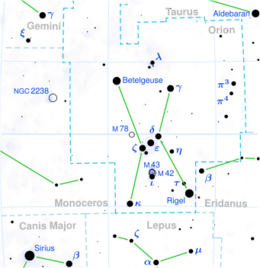Astronomy:Omicron1 Orionis
| Observation data Equinox J2000.0]] (ICRS) | |
|---|---|
| Constellation | Orion |
| Right ascension | 04h 52m 31.96357s[1] |
| Declination | +14° 15′ 02.3215″[1] |
| Apparent magnitude (V) | 4.65 - 4.88[2] |
| Characteristics | |
| Spectral type | M3S III[3] |
| U−B color index | +2.03[4] |
| B−V color index | +1.74[4] |
| Variable type | SRb[2] |
| Astrometry | |
| Radial velocity (Rv) | −8.40±0.23[5] km/s |
| Proper motion (μ) | RA: −0.05[1] mas/yr Dec.: −54.81[1] mas/yr |
| Parallax (π) | 5.01 ± 0.71[1] mas |
| Distance | approx. 650 ly (approx. 200 pc) |
| Details | |
| Mass | 0.9[6] M☉ |
| Radius | 214±29[6] R☉ |
| Luminosity | 4,046[7] L☉ |
| Surface gravity (log g) | 0.76±0.29[8] cgs |
| Temperature | 3,465±27[8] K |
| Metallicity [Fe/H] | −0.03±0.12[8] dex |
| Other designations | |
| Database references | |
| SIMBAD | data |
Omicron1 Orionis (ο1 Ori) is a binary star[9] in the northeastern corner of the constellation Orion. It is visible to the naked eye with an apparent visual magnitude of 4.7.[4] Based upon an annual parallax shift of 5.01±0.71 mas, it is located approximately 650 light years from the Sun. At that distance, the visual magnitude of the star is diminished by an interstellar absorption factor of 0.27 due to intervening dust.[5]
The two components of this system have an orbital period of greater than 1,900 days (5.2 years).[9] The primary component is an evolved red giant with the stellar classification of M3S III. This is an S-type star on the asymptotic giant branch.[3] It is a semiregular variable[11] that is pulsating with periods of 30.8 and 70.7 days, each with nearly identical amplitudes of 0.05 in magnitude.[12] The star has an estimated 90% of the mass of the Sun but has expanded to 214 times the Sun's radius.[6] It shines with 4,046[7] times the solar luminosity from its outer atmosphere at an effective temperature of 3,465 K.[8]
References
- ↑ 1.0 1.1 1.2 1.3 1.4 van Leeuwen, F. (2007), "Validation of the new Hipparcos reduction", Astronomy and Astrophysics 474 (2): 653–664, doi:10.1051/0004-6361:20078357, Bibcode: 2007A&A...474..653V.
- ↑ 2.0 2.1 Samus, N. N. et al. (2009). "VizieR Online Data Catalog: General Catalogue of Variable Stars (Samus+ 2007-2013)". VizieR On-line Data Catalog: B/GCVS. Originally Published in: 2009yCat....102025S 1. Bibcode: 2009yCat....102025S.
- ↑ 3.0 3.1 Cox, N. L. J. et al. (January 2012), "A far-infrared survey of bow shocks and detached shells around AGB stars and red supergiants", Astronomy & Astrophysics 537: 28, doi:10.1051/0004-6361/201117910, A35, Bibcode: 2012A&A...537A..35C.
- ↑ 4.0 4.1 4.2 Mermilliod, J.-C. (1986), "Compilation of Eggen's UBV data, transformed to UBV (unpublished)", Catalogue of Eggen's UBV Data (SIMBAD), Bibcode: 1986EgUBV........0M.
- ↑ 5.0 5.1 Famaey, B. et al. (January 2005), "Local kinematics of K and M giants from CORAVEL/Hipparcos/Tycho-2 data. Revisiting the concept of superclusters", Astronomy and Astrophysics 430 (1): 165–186, doi:10.1051/0004-6361:20041272, Bibcode: 2005A&A...430..165F.
- ↑ 6.0 6.1 6.2 Cruzalèbes, P.; Jorissen, A.; Rabbia, Y.; Sacuto, S.; Chiavassa, A.; Pasquato, E.; Plez, B.; Eriksson, K. et al. (2013), "Fundamental parameters of 16 late-type stars derived from their angular diameter measured with VLTI/AMBER", Monthly Notices of the Royal Astronomical Society 434 (1): 437–450, doi:10.1093/mnras/stt1037, Bibcode: 2013MNRAS.434..437C.
- ↑ 7.0 7.1 McDonald, I. et al. (2012), "Fundamental Parameters and Infrared Excesses of Hipparcos Stars", Monthly Notices of the Royal Astronomical Society 427 (1): 343–57, doi:10.1111/j.1365-2966.2012.21873.x, Bibcode: 2012MNRAS.427..343M.
- ↑ 8.0 8.1 8.2 8.3 Prugniel, Ph. et al. (July 2011), "The atmospheric parameters and spectral interpolator for the MILES stars", Astronomy & Astrophysics 531: A165, doi:10.1051/0004-6361/201116769, Bibcode: 2011A&A...531A.165P.
- ↑ 9.0 9.1 Udry, S.; Jorissen, A.; Mayor, M.; Van Eck, S. (July 1998), "A CORAVEL radial-velocity monitoring of giant BA and S stars: Spectroscopic orbits and intrinsic variations. I.", Astronomy and Astrophysics Supplement 131: 25–41, doi:10.1051/aas:1998249, Bibcode: 1998A&AS..131...25U.
- ↑ "/ftp/cats/more/HIP/cdroms/cats". Strasbourg astronomical Data Center. https://cdsarc.cds.unistra.fr/viz-bin/ftp-index?/ftp/cats/more/HIP/cdroms/cats.
- ↑ Glass, I. S.; Van Leeuwen, F. (2007), "Semiregular variables in the solar neighbourhood", Monthly Notices of the Royal Astronomical Society 378 (4): 1543–1549, doi:10.1111/j.1365-2966.2007.11903.x, Bibcode: 2007MNRAS.378.1543G.
- ↑ Tabur, V. et al. (December 2009), "Long-term photometry and periods for 261 nearby pulsating M giants", Monthly Notices of the Royal Astronomical Society 400 (4): 1945–1961, doi:10.1111/j.1365-2966.2009.15588.x, Bibcode: 2009MNRAS.400.1945T.
 |



